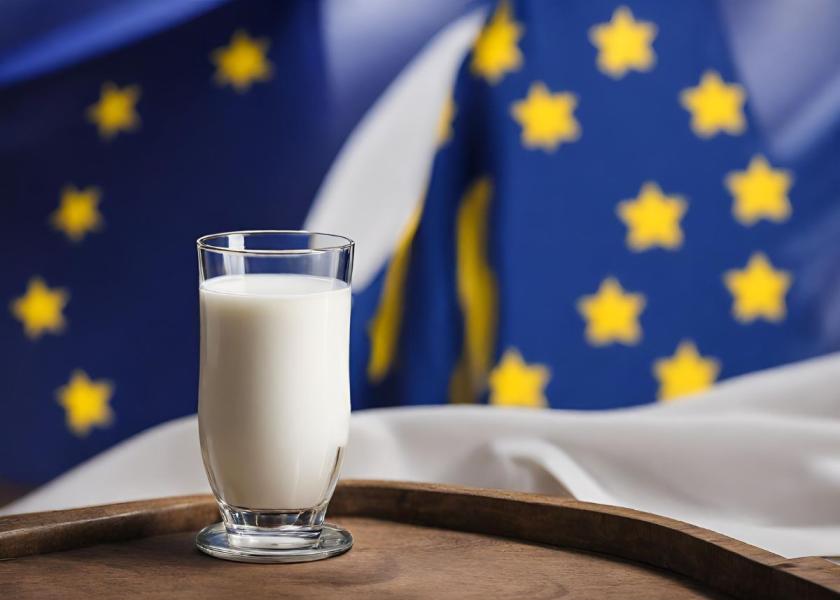Discover why EU milk production is forecasted to drop 0.3% in 2024. How will declining cow numbers and rising costs impact the dairy industry? Read more to find out.

European Union milk production is set to face another challenging year, continuing its downward trend into 2024. Several factors contribute to this decline, with a predicted 0.3% drop in cow milk production. As the number of dairy cows falls below 20 million for the first time, it’s evident that consistent growth in cow productivity won’t fully offset the shrinking cow inventories. Rising production costs and lower farm-gate milk prices further exacerbate the situation, making milk production less profitable for EU farmers. Join us as we delve further; these elements paint a comprehensive picture of the EU’s milk production landscape in 2024.
EU Dairy Herds Dwindling: First-Ever Drop Below 20 Million Cows Marks 2024’s Start
| Country | Dairy Cows in Milk (January 2024) | Expected Change in Dairy Farmer Numbers (2024) | Milk Production (Forecast for 2024) |
|---|---|---|---|
| Germany | 4.0 million | Decrease | Stable |
| France | 3.5 million | Decrease | Slight Decrease |
| Poland | 2.8 million | Decrease | Slight Increase |
| Belgium | 0.6 million | Decrease | Slight Decrease |
| Netherlands | 1.6 million | Minimal Change | Stable |
| Ireland | 1.5 million | Minimal Change | Decrease |
At the start of 2024, the EU saw a significant change in its dairy industry: dairy cows dropped below 20 million, hitting 19.7 million. This marks a historic low and indicates a continuing downward trend in cow numbers, which is expected to persist throughout the year.
The Double-Edged Sword of Rising Cow Productivity Amid Shrinking Herds
Even though each cow produces more milk, more is needed to make up for the overall decline in cow numbers across the EU. Simply put, fewer cows mean less milk overall. This imbalance contributes directly to the forecasted 0.3% drop in milk production for 2024. Despite individual productivity gains, the milk output is declining due to the shrinking herds.
A Temporary Respite: Early 2024 Sees Milk Deliveries Surge Before Expected Decline
Time PeriodMilk Deliveries (MMT)Change (% Year-on-Year)Average Farm Gate Milk Price (EUR/100kg)
January-February 2023 24.0 – 40.86
January-February 2024 24.4 1.7% 35.76
Full Year 2023 145.24 -0.03% 39.50
Full Year 2024 (Forecast) 144.8 -0.3% 37.00
Early 2024 saw a 1.7% rise in cow’s milk deliveries compared to the same period in 2023. However, this boost is short-lived. Many farmers are expected to sell their cows or exit milk production later in the year, leading to a decline in deliveries.
The Multifaceted Challenges Shaping Europe’s Dairy Economy
The economic landscape for dairy farmers is becoming more challenging. A key issue is the steady drop in farm-gate milk prices since early 2023, significantly affecting profitability.
Production Costs: High production costs for energy, fertilizers, and labor persist, squeezing farmers’ margins despite some recent reductions.
Geographical Impact: In Germany, France, Poland, and Belgium, smaller and less efficient farms are hardest hit. The pressure from lower milk prices and high input costs drives many to reduce herd sizes or stop milk production.
Environmental Regulations: Environmental rules in the Netherlands and Ireland seek to cut nitrogen emissions, which are expected to negatively affect herd numbers and production costs in the long term.
Overall, larger farms may better cope, but the trend toward consolidation continues due to falling profits and rising costs.
Environmental Regulations Cast Long Shadows Over EU Dairy Farming
Environmental regulations are threatening Europe’s dairy farming. New measures to curb nitrogen emissions are adding pressure on struggling farmers in the Netherlands and Ireland.
For example, the Netherlands aims to cut nitrogen emissions by 50% by 2030, including reducing the number of dairy cows and relocating farms. Ireland’s targets similarly demand stricter manure management and sustainable farming practices, both costly and complex.
These regulations, combined with high production costs and declining milk prices, make it challenging for smaller farms to stay in business. Many are choosing to exit the market rather than invest in expensive upgrades.
As a result, smaller farms are shutting down, and larger farms need help to maintain their herd sizes. Although these regulations are essential for a greener future, they add another layer of complexity to the EU dairy industry’s challenges.
Generation Renewal Crisis Accelerates Market Consolidation in EU Dairy Sector
A growing trend in market consolidation and farm closures is evident within the EU dairy sector. One key issue here is the challenge of generation renewal. Younger generations are increasingly hesitant to continue milk production due to the heavy workload and tight profit margins. Elevated production costs and decreasing farm-gate milk prices also make it challenging for smaller, less efficient farms to stay in business.
However, larger and more professional farms show notable resilience. They often have better infrastructure, access to advanced technology, and excellent financial stability, allowing them to maintain herd numbers despite broader declines. By leveraging economies of scale and more efficient practices, these farms can better absorb economic shocks and comply with environmental regulations.
This disparity between small and large farms is accelerating market consolidation. As smaller farms exit, larger ones are absorbing their market share. While the total number of dairy farms is decreasing, those that remain are becoming more advanced and better equipped to tackle future challenges in the dairy economy.
Record-High Milk Prices in 2022 Spark Production Surge, Only to Shatter in 2023-2024
The surge in milk deliveries in 2022 and 2023 stemmed from record-high EU farm gate milk prices in 2022, peaking in December. These prices incentivized farmers to boost production despite rising costs, supporting the dairy industry at that time.
However, these prices began to fall from May 2023 through March 2024, squeezing farmers financially. Although still above the 5-year average, the decline sharply contrasted with 2022’s profitability. With global milk production up and dairy demand fluctuating, EU farmers adjusted their production levels, paving the way for a predicted drop in milk deliveries in 2024.
The Ripple Effect: How Global Market Dynamics Shape EU Milk Prices
Global market dynamics significantly impact EU milk prices. The world’s largest dairy exporters, including Australia, the United States, the UK, and New Zealand, have increased production, leading to an oversupply that pressures prices downward. This makes it challenging for EU producers to maintain their margins.
Simultaneously, demand from major importers like China and some Middle Eastern countries is declining. Various factors, including trade tensions and shifting consumer preferences, contribute to this weaker demand.
This supply-demand imbalance has reduced farm gate milk prices in the EU. While European prices remain higher than those of international competitors, more than this advantage is needed to counteract the rising production costs and reduce global demand. The EU dairy industry must navigate these challenges to stay competitive and sustainable.
Price Disparities in Global Dairy: EU’s Costly Position Against New Zealand and US Competitors
When you look at milk prices, you’ll notice that the EU’s are much higher than those of other major exporters like New Zealand and the US. In February 2024, the EU’s milk price hit EUR 46.42 per 100 kilograms. That’s 27% more than New Zealand’s and 18% more than the US.
These higher prices mean EU dairy products cost more to produce and sell, making it challenging for EU producers to compete globally. Higher costs can squeeze farmers further, especially with high input costs and changing demand.
Weather Woes: Uneven Conditions Across Europe Impact Dairy Farming
In 2024, weather was vital in shaping feed and pasture conditions across Europe. Spring brought warm temperatures and balanced rainfall, leading to good green feed availability. However, the northwest, especially Ireland, faced challenges. Ireland’s dairy farming, which relies on cattle grazing for up to nine months, has struggled with wet soils and recent rains. These conditions hindered field access and grassland regrowth, severely impacting milk production.
The Bottom Line
In summary, EU milk deliveries are forecast to dip to 144.8 million metric tons (MMT) in 2024. Unfavorable weather and high input costs for energy and fertilizers are straining farmer margins. Despite brief boosts in productivity, these challenges will likely persist throughout the year.
Key Takeaways:
- Decline in Cow Numbers: Cow numbers fell below 20 million for the first time in early 2024, indicating a continuing downward trend.
- Productivity vs. Herd Size: Increased productivity per cow is not enough to counterbalance the overall decrease in herd sizes.
- Initial Surge in Milk Deliveries: Early 2024 saw a 1.7% increase in milk deliveries, but this is expected to decline as more farmers exit the industry.
- Decreasing Profitability: Farm-gate milk prices have been falling since early 2023, alongside high production costs, squeezing farmers’ profit margins.
- Impact of Environmental Regulations: Government plans to cut nitrogen emissions in countries like the Netherlands and Ireland are affecting herd numbers.
- Market Consolidation: The industry is seeing greater consolidation, with smaller, less efficient farms closing and bigger farms maintaining their herd sizes.
- Weather Complications: Varying weather conditions across Europe in 2024 have impacted green feed availability and pasture conditions, particularly in Ireland.












